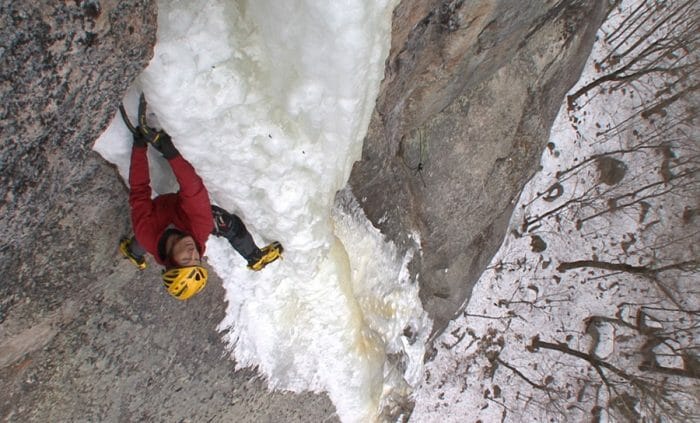We recommend you visit the Uphill Athlete strength training landing page—Strength Training for the Mountain Athlete—for a full rundown of how to develop both general and specific strength for your chosen mountain sport.
The Uphill Athlete KIS Strength Series
-by Steve House, Uphill Athlete co-founder and Master Coach
Endurance athletes and climbers do not tend to come from strength and conditioning backgrounds. They don’t hang out in globo-gyms and few know an Olympic bar from an Airdyne. However, as soon as you start reading a word about strength training, the terms and protocols come rapid-fire: reps, sets, 1RM, OHS, and of course the dreaded TGU.
Increasing complexity is a problem. Does this progression sound familiar? You start off wanting to be stronger on steep routes, so you climb more steep routes. You want to run faster, so you buy a GPS watch and run faster. That works for a couple weeks, but then you plateau and don’t get stronger, or faster, or maybe end up injured. I’m a big advocate of simplicity and a big fan of getting it done. So let’s put the two ideas together and talk about strength training.
Strength Basics
Gym-oriented strength and conditioning people love the math, the terms, the precision of it all and in a well-intended effort to improve, they often succumb to complexity creep. The athletic world does not work this way. Strength training for all the sports we address is critical. And we’ve talked about that here, and here, and here. But the important things to know, for 99 percent of us, are the basics.
Core Strength
Everyone knows about it and everyone has to do it. There are a million exercises, videos, and protocols being sold out there. and most of them are overthought, overspecialized, and oversold. We only have so many muscles in our core, and from the perspective of improving their strength, the main problems are that they are composed almost entirely of slow twitch fibers and they lie deep in our bodies. Slow twitch fibers are slow to respond to strength protocols. Deep muscles are hard for many people to activate without hands-on coaching.
KIS (Keep It Simple) says that you can hit all these core muscles with about 10 exercises that you can do almost anywhere. Though there are many good ways to do it, here is our basic version and here is a slightly more advanced version.
Everyone should do core strength training twice a week. Additionally, typically at the same time, you should do one of the following:
General Strength Protocols: First 4–8 Weeks of Consecutive Training
Go look at the social-media videos of your favorite pro athlete training in the gym during their off-season. They’re doing this. You should too. A balanced menu of multijoint movements, done circuit style, 10–12 at a time. This is general strength.
Optional Hypertrophy Protocols
A word you don’t know is always a warning sign of imminent complexity creep. So excuse me for this quick diversion. Hypertrophy means muscle growth. Some people need it. Many don’t. In our sports we have to haul everything around. So there is an optimal size and weight to an endurance athlete. Kilian Jornet is about 5-foot-7 and weighs about 125 pounds (57 kilograms) when he’s racing. I am 5-foot-10 and weighed 160 pounds when I climbed Nanga Parbat (and 148 when I got back down). Typically the athletes who need to gain muscles are youth athletes, most often young women, and those new to sport.
Most of you skip this, but it is important to understand how it works: Repeating a movement with a lot of resistance until you can’t do it anymore stimulates muscles to grow larger. Remember that! Have you ever attempted the crux move on a sport climbing project repeatedly until you got weaker and weaker? Guess what you were doing that night when you slept. Yep, growing bigger muscles and, by extension, making your body heavier. Probably not what you intended. Athletes in our sports don’t want to be big.
Repeating a movement with a lot of resistance until you can’t do it anymore stimulates muscles to grow larger. Remember that!
Max Strength Protocols: 8–16 Weeks of Consecutive Training
Max strength refers to a simple protocol that was originally designed by Russian coaches many decades ago (from whom we inherited the bulk of what is known today about strength training). The beauty of this is that the training stimulus is largely neurological. It’s teaching existing muscle fibers to work in a more coordinated way. No new muscle fibers (read: weight) required.
A foolproof program is, surprise, simple. Choose four multijoint exercises using free weights (rocks or sacks of rocks work in a pinch), performed as two couplets. A couplet means that you do one exercise, switch to the other, and repeat until you’re done with all the prescribed sets and reps. The key to this protocol is increasing the weight as the number of reps drop. This is where self-coaching comes in, increasing the weights appropriately as the number of movements (reps) drop so that you’re at about 75–90 percent of failure on the last one. Not to failure. Never go to failure (see “Hypertrophy Protocols” above) unless you need more muscle to carry around.
The decades-old rest recommendation for this protocol is 30 seconds (a minimal rest) when moving from one exercise to the next, and about 2 minutes of rest (a significant rest) before starting the next couplet.
Here is a typical max strength couplet we use with many of our coached athletes: weighted pull-ups and box step-ups, alternating between the pull-ups and box step-ups.
Do 6 sets of 4 reps, 4 reps, 3 reps, 3 reps, 2 reps, 2 reps.
Rest 30 seconds moving from the pull-up to the step-up. Rest 2 minutes between couplets.
In this example, for the weighted pull-ups you might use 10 kilograms for the 2 sets of 4 reps, then 12 kilograms for the 2 sets of 3 reps, and finally 15 kilograms for the last 2 sets of 2 reps. For box step-ups you might use 30 kilograms, 40 kilograms, and 45 kilograms loaded in a backpack. (I stage the backpack on a table so I don’t have to pick it up off the ground.)
This same weight/set/rep format works for other exercises, such as a push-up/lunge couplet. For the push-ups I wear a weight vest and I hold a weight to my chest for the lunges.
Muscular Endurance: 4–8 Weeks
Everyone loves muscular endurance (ME) because it works and it’s fun. (ME is sometimes referred to as power endurance or strength endurance; multiple terms—another sign of creeping complexity.) We discuss ME in depth here and here, and define it here.
Bottom line? Don’t split hairs with your strength workouts. Keep it simple, and most importantly, do it.


